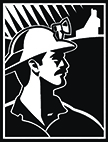
A RICH and UNIQUE LANDSCAPE
Gay, Michigan hugs the eastern shore of the Keweenaw Peninsula - a
formation of Precambrian rock, embedded with native copper deposits from
lava flows a billion years ago. About 2.6 million years ago a
two-mile-thick sheet of ice covered the region. As the ice receded,
about 11,000 years ago, Lake Superior and the Keweenaw emerged.
As the ice sheet over the Great Lakes began to melt around 11,000 years ago, it retreated creating ancient Lakes Duluth and Baraga. Gradually the Keweenaw Peninsula (dashed white line) began to emerge as Lake Superior took on its modern shape and elevation, about 2,000 years ago.
Credit: Map modified by D. Lizzadro-McPherson, Michigan Technological University, Geospatial Research Facility, 2022
The Gay area is rich with unique landscape features important to its human history. Forested wetlands surround Gay to the west. Located just offshore is Buffalo Reef, an underwater cobblestone reef and vital fish habitat. Several miles inland is the Keweenaw fault with the Mohawkite copper deposits in the Kearsarge lode mined by the Wolverine and Mohawk mines and processed in the Gay stamp mills.Seven thousand years ago, explorers from Native American cultures to the south visited the Keweenaw Peninsula, formed seasonal settlements, and mined copper that was traded in a large network. About 1,500 years ago, the Anishinaabe began a slow migration from the East Coast of North America. Several hundred years later, the Ojibwa separated and settled around Lake Superior, including near Gay. Family-based bands moved around the landscape seasonally, and harvested berries, medicinal plants and wild rice from the wetlands, and fish from Buffalo Reef. Father Menard, a French Jesuit, first visited a small Ojibwa village at the foot of Keweenaw Bay in 1660. The Ojibwa soon began to trade with the French from Quebec, and subsequently with the British and Americans. In 1820, the U.S. Government sent geologists to the Keweenaw to investigate claims of mineral deposits.
Western sources noted in the 1600s that the Ojibwa in the area numbered several hundred. Their trails crisscrossed from Keweenaw Bay to Copper Harbor, Misery Bay, Ontonagon, and Lac Vieux Desert. Today, these trails mark the home territory of the Keweenaw Bay Indian Community (KBIC).
U.S. interests in copper mining and white pine forests pressed for the Treaty of 1842 in which eleven Ojibwa bands along southern Lake Superior ceded rights to minerals but retained hunting, fishing and harvesting rights in their homeland. A second treaty was signed in 1854 to protect the Ojibwa homelands and create the L’Anse Reservation. Rapidly developing mining interests and Government sale of ceded lands pressured the Keweenaw Bay band to settle around L’Anse and Baraga. Ojibwa actively continued to exercise their treaty rights and harvest blueberries, wild rice, and fish around the Keweenaw into the twenty-first century.
Transporting logs to Hebard’s sawmill in Pequaming in the early 1900s. Courtesy: MTU Archives.



